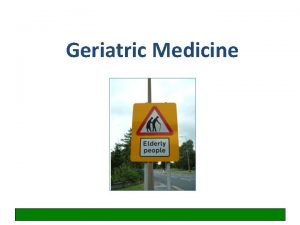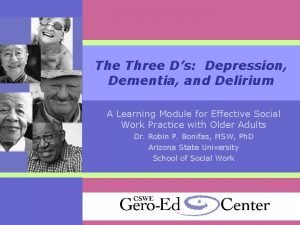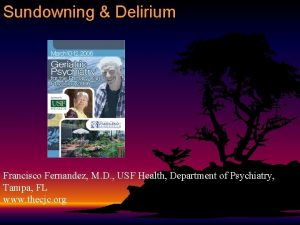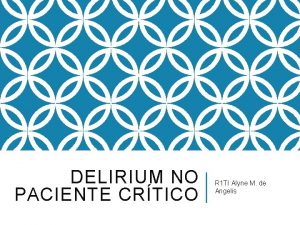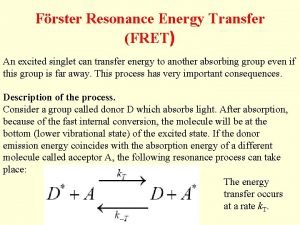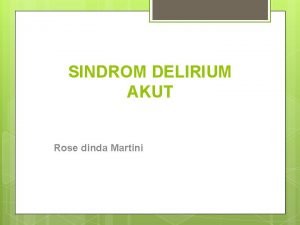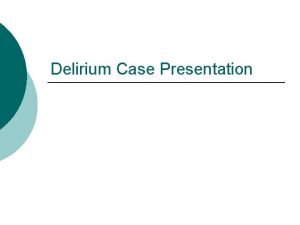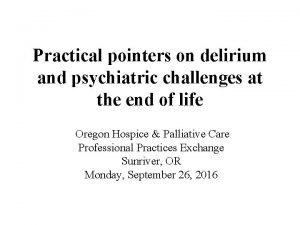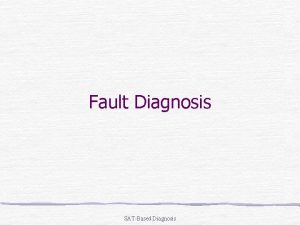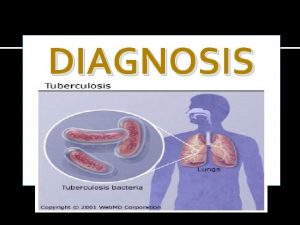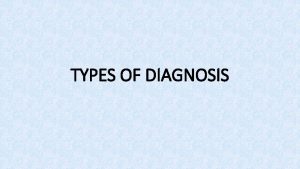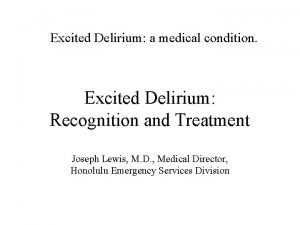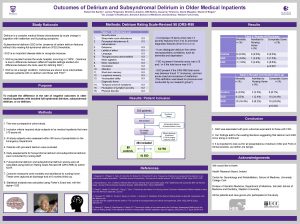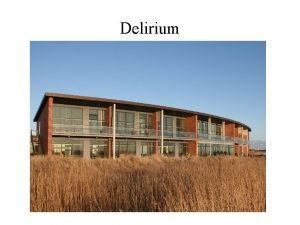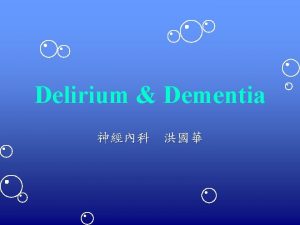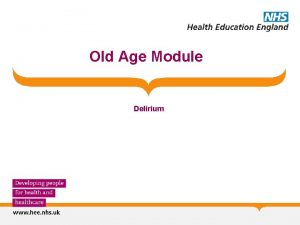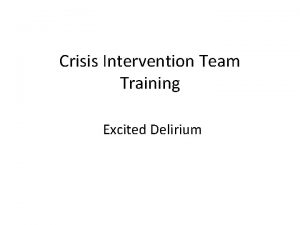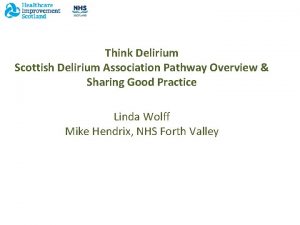Delirium n 2006 12 27 Delirium Early diagnosis















- Slides: 15

Delirium n 2006 -12 -27

Delirium Early diagnosis and resolution of symptoms are correlated with the most favorable outcomes. n It must be treated as a medical emergency. n Delirium is not a disease but a syndrome with multiple causes. n

Pathophysiology Hyperactive delirium -- patients in a state of alcohol withdrawal or intoxication with to phencyclidine (PCP), amphetamine, and lysergic acid diethylamide (LSD). n Hypoactive delirium -- patients in states of hepatic encephalopathy and hypercapnia. n Mixed delirium -- individuals display daytime sedation with nocturnal agitation and behavioral problems. n

Pathophysiology The mechanism of delirium still is not fully understood. n Research in these areas still is limited. n The main hypothesis is reversible impairment of cerebral oxidative metabolism and multiple neurotransmitter abnormalities. n

Mortality/Morbidity In patients who are admitted with delirium, mortality rates are 10 -26%. n Patients who develop delirium during hospitalization have a mortality rate of 2276%. n In patients who are elderly and patients in the postoperative period, delirium may result in a prolonged hospital stay, increased complications, increased cost, and long-term disability. n

History n Nursing notes can be very helpful for documentation of episodes of disorientation, abnormal behavior, and hallucinations. n Delirium is mistaken for dementia or depression, especially when patients are quiet or withdrawn.

History n Main l l l symptoms Clouding of consciousness Difficulty maintaining or shifting attention Disorientation Illusions Hallucinations Fluctuating levels of consciousness

History n Neurological l l symptoms Dysphasia Tremor Asterixis in hepatic encephalopathy and uremia Motor abnormalities

Causes n DSM-IV classification of delirium – Delirium due to general medical condition – Substance intoxication delirium – Substance withdrawal delirium – Delirium due to multiple etiologies – Delirium not otherwise specified

Causes n Some of the other common reversible causes include the following: – Hypoxia – Hypoglycemia – Hyperthermia – Anticholinergic delirium – Alcohol or sedative withdrawal

Causes n n n Other causes of delirium include the following: Infections Metabolic abnormalities Structural lesions of the brain Postoperative states Miscellaneous causes, such as sensory deprivation, sleep deprivation, fecal impaction, urinary retention, and change of environment

Workup n n n Complete blood cell count with differential - Helpful to diagnose infection and anemia Electrolytes - To diagnose low or high levels Glucose - To diagnose hypoglycemia, diabetic ketoacidosis, and hyperosmolar nonketotic states Renal and liver function tests - To diagnose liver and renal failure Thyroid function studies - To diagnose hypothyroidism Urine analysis - Used to diagnose urinary tract infection Urine and blood drug screen - Used to diagnose toxicological causes Thiamine and vitamin B-12 levels - Used to detect deficiency states of these vitamins Tests for bacteriological and viral etiologies - To diagnose infection Sedimentation rate Drug screen including alcohol level

Workup – Imaging studies n Neuroimaging – Perform CT scan of the head. – Magnetic resonance imaging (MRI) of the head may be helpful in the diagnosis of stroke, hemorrhage, and structural lesions. n Electroencephalogram n Chest x-ray is used to diagnose pneumonia or congestive heart failure

Workup – Other Tests Lumbar puncture is indicated when CNS infection is suspected as a cause of delirium or when the source for the systemic infection cannot be determined. n Pulse oximetry is used to diagnose hypoxia as a cause of delirium. n Electrocardiogram is used to diagnose ischemic and arrhythmic causes n

Treatment When delirium is diagnosed or suspected, the underlying causes should be sought. n Despite every effort, no cause for delirium can be found in approximately 16% of patients. n Components of delirium management include supportive therapy and pharmacological management. n
 Nursing process and critical thinking
Nursing process and critical thinking Nursing diagnosis for community health
Nursing diagnosis for community health Perbedaan diagnosis gizi dan diagnosis medis
Perbedaan diagnosis gizi dan diagnosis medis Medical diagnosis and nursing diagnosis difference
Medical diagnosis and nursing diagnosis difference Second phase of nursing process
Second phase of nursing process Delirium definition
Delirium definition Difference between dementia and delirium
Difference between dementia and delirium Difference between delirium and dementia ppt
Difference between delirium and dementia ppt Cam icu escala
Cam icu escala Escala de cam
Escala de cam Energy transfer theory
Energy transfer theory Dr rose dinda martini
Dr rose dinda martini Kesadaran gcs
Kesadaran gcs Delirium care pathways
Delirium care pathways Delirium case presentation
Delirium case presentation Nash delirium
Nash delirium





